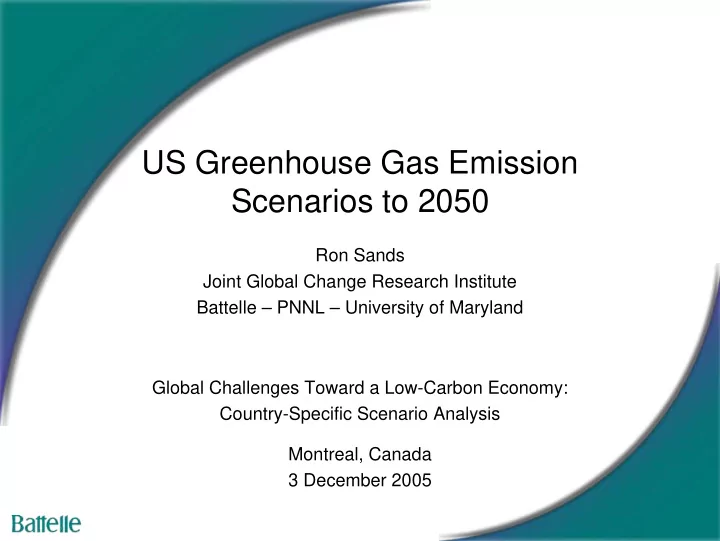

US Greenhouse Gas Emission Scenarios to 2050 Ron Sands Joint Global Change Research Institute Battelle – PNNL – University of Maryland Global Challenges Toward a Low-Carbon Economy: Country-Specific Scenario Analysis Montreal, Canada 3 December 2005
Introduction � Results for the United States from Energy Modeling Forum study (EMF-21) � Goals � Provide policy-relevant analysis (not policy prescriptive) � Economic comparison of major classes of greenhouse gas (GHG) mitigation options � Classes of Mitigation Options � Energy efficiency improvements � Fuel switching � Carbon dioxide capture and storage (CCS) � Non-CO 2 GHGs � Terrestrial options (biofuels, carbon in soils, carbon in trees) � Main Conclusions � No single model can represent all relevant processes � Each type of mitigation option contributes significant fraction of total 2
Models � Energy System and Geologic Storage � CO 2 emissions from energy combustion, carbon dioxide capture and storage from electricity generation � Battelle Second Generation Model � Non-CO 2 Greenhouse Gases � Methane, Nitrous Oxide, F-gases � Energy Modeling Forum (EMF-21) baselines and marginal abatement cost curves � Agricultural Offsets � Soil sequestration, Afforestation, Biofuel Offsets � Agricultural Sector Model (McCarl, B.A. and Schneider, U.A. 2001. “Greenhouse Gas Mitigation in U.S. Agriculture and Forestry.” Science 294 , 2481-2482.) 3
U.S. Carbon Equivalent Emissions (baseline) 4,000 3,500 million tons carbon equivalent 3,000 2,500 F-gases nitrous oxide 2,000 methane energy system + CCS 1,500 1,000 500 0 1990 2000 2010 2020 2030 2040 2050 4
U.S. Carbon Equivalent Emissions ($100 constant) 4,000 3,500 million tons carbon equivalent 3,000 2,500 F-gases nitrous oxide 2,000 methane energy system + CCS 1,500 1,000 500 0 1990 2000 2010 2020 2030 2040 2050 5
U.S. Carbon Equivalent Emissions ($200 constant) 4,000 3,500 million tons carbon equivalent 3,000 2,500 F-gases nitrous oxide 2,000 methane energy system + CCS 1,500 1,000 500 0 1990 2000 2010 2020 2030 2040 2050 6
Carbon Dioxide Capture and Storage (CCS) � Carbon Dioxide Capture from Electric Power Generation � Technologies with and without CCS � Coal integrated gasification combined cycle (IGCC) � Natural gas combined cycle (NGCC) � Engineering cost model for capture process from David and Herzog, 2000, “The Cost of Carbon Capture,” Proceedings of the Fifth International Conference on Greenhouse Gas Control Technologies � Geologic Storage � Cost of storage assumed constant ($40 per tC) � Ongoing work at Battelle to construct storage supply curves for the US and other countries 7
U.S. Electricity Baseline Scenario 9,000 8,000 7,000 6,000 billion kWh 5,000 coal (IGCC) 4,000 coal (PC) 3,000 2,000 gas (NGCC) gas (single cycle) 1,000 oil hydro nuclear 0 1990 2000 2010 2020 2030 2040 2050 8
Constant-Carbon-Price Scenario Carbon price of $200 per tC starting in 2015 9,000 8,000 7,000 6,000 IGCC+CCS billion kWh 5,000 PC+CCS 4,000 IGCC NGCC+CCS 3,000 PC 2,000 NGCC gas (single cycle) 1,000 oil hydro nuclear 0 1990 2000 2010 2020 2030 2040 2050 9
Economic Comparison of Mitigation Options � View 1: Components of US emission reductions relative to baseline over time � Constant carbon price of $200 per t C-eq � Components � Energy system CO 2 � Carbon dioxide capture and storage � Non-CO 2 GHGs (methane, nitrous oxide, F-gases) � Terrestrial options (soil carbon, afforestation, biofuels) � View 2: Cumulative emission reductions over a range of carbon prices � Results derived from a set of constant-carbon-price experiments � Carbon prices up to $300 per t C-eq � Expressed as cumulative marginal abatement cost curves � Cumulative emissions reductions over 40 years 10
1,800 Components of U.S. afforestation 1,600 Emissions Reductions at $200 per t CE biofuel 1,400 afforestation million metric tons carbon equivalent soil seq. 1,200 biofuel afforestation 1,000 soil seq. afforestation biofuel F-gas N2O soil sequestration 800 CH4 afforestation biofuel offset F-gas N2O soil seq. CCS CH4 F-gas biofuel F-gases 600 N2O nitrous oxide CH4 methane F-gas N2O 400 energy system CO2 CH4 CO2 CO2 CO2 200 CO2 CO2 0 1990 2000 2010 2020 2030 2040 2050 11
U.S. Cumulative Emissions Reductions (40 years with constant carbon price) $350 $300 $250 energy $200 carbon energy+CCS price all GHGs $150 all GHGs + Ag/For $100 $50 $0 0 10,000 20,000 30,000 40,000 50,000 60,000 70,000 million metric tons carbon equivalent (2013-2052) 12
Conclusions � No single model can represent all relevant processes � Bottom-up: specialized analysis or models by sector � Agriculture / Forestry � Buildings � Industry � Transportation � Electricity generation � Top-down: combine results across sectors � Each type of mitigation option contributes significant fraction of total � Energy efficiency improvements � Fuel switching � CO 2 capture and storage � Non-CO 2 greenhouse gases � Terrestrial storage and biofuels � Potential of each mitigation option varies across countries 13
Recommend
More recommend